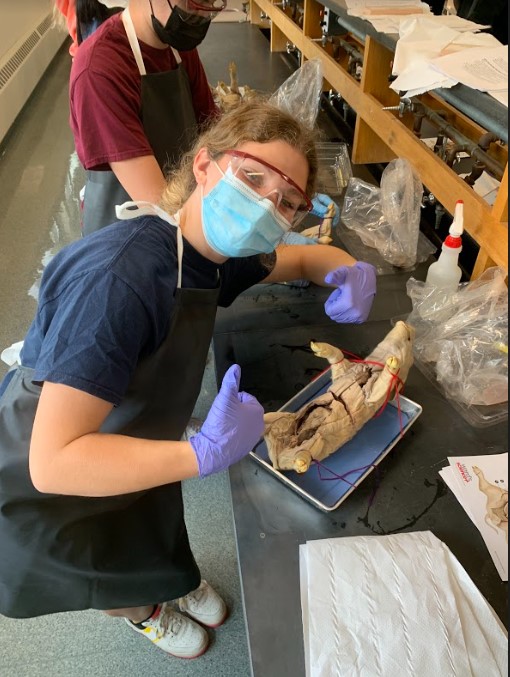Dissection important part of LHS science classes
September 20, 2022
“All right everyone, since the AP exam is over, we’re going to dissect fetal pigs. Field trip to the closet!” says Mrs. Sands. My classmates and I looked at each other, some frightened and some filled with excitement– I was so excited. The closet they were stored in, was cold, damp, and filled with vacuumed sealed bags of animal cadavers and buckets of sheep hearts. After finding the fetal pigs from the closet we came back to the room to start opening the box to find the bags they were living in so we could start examining and dissecting them.
Doing dissections in a classroom is a controversial topic because some believe it’s inhumane and promotes violent tendencies and disturbing curiosity among students. According to PETA, “about 20 million animals are used each year in the classroom,” that number is for both animals being dissected dead and alive. Animals like mice, rats, rabbits, frogs, turtles, goats, fetal pigs, cats, ferrets, dogs, and sheep are used for all kinds of experiments; for research purposes, they can be dissected while still alive so they can use their functioning organs to test their hypothesis. Most of them, according to PETA, are taken straight from the wild except for the fetal pig– they are taken from the slaughterhouse. Of course, there are other ways to experience anatomy and dissection: computer software.
However, a computer can not replace the hands-on learning and observing that can be done by dissection. One student can agree, Kylie Gauvin has dissected two animals – a fetal pig and a frog. She believes that there are more benefits to having “a hands-on experience and an education with interactive learning.” She also believes there are more benefits because dissections will be done in college and learning how to properly do them in high school can prepare you for a bigger learning environment– especially if you want to go into the science field.
When asked if she felt pressure to dissect the animal or felt nervous, she said, .”
For some students, it’s proven to be a more helpful lesson. According to Britannica, “87.5% of teachers polled said that it was more important to dissect than to teach it on a whiteboard. While 56.3% agreed there are no substitutions for real animal dissection.”
Studies have shown it is more beneficial for students to have a hands-on learning experience and dissection is often one of the most memorable experiences for them. Despite the controversies of where the animals came from, most believe the animals should not be taken from the wild because it’s taking them away from their habitat for human research.
Mr. Lee, an anatomy teacher, agreed that there are more benefits to a dissection. “Dissection can be extremely beneficial in the right context. For example, in AP Biology, when a pig dissection is done while studying body systems, it provides a concrete example of the system.”
Students can decide not to participate: “They can use an online simulation or watch a video of the dissection.” Instead of obtaining animals from the wild or breeding them for the main purpose of dissecting them, Mr. Lee prefers to use fetal pigs because “they are a byproduct of the livestock industry.”
Mr. Lee’s thoughts seem to be around the majority, according to many articles by Britannica and ProCon, most of the public are willing to participate in a dissection in a classroom setting if the animals were taken in a more ethical way– not just raised to be dissected or taken from their habitat.
In seventh grade, Mrs. Sands first dissected a frog, from there on her experience with dissection only grew. During college she dissected a cat and when she decided to switch from the biotech industry to become a teacher she thought dissection was super important.
“It’s beneficial for learning comparative anatomy,” she said. “The benefit is seeing how the organs form and work together in organ systems.”
She also thinks that dissection is very memorable in a classroom environment because it leaves such a big impression and the dissection is exciting. However, she always makes participation in the dissection optional, if a student doesn’t want to participate there is an online dissection they can use.
“It is not inhumane to dissect animals in school. Dissection serves as a means to understand anatomy and physiology of an organism and make connections on how it relates to the human body. I always pre-teach the lesson so students know what to expect and also respect the animals that we are dissecting.” Finally, she added that “I’ve always had positive experiences with dissection and always found it fascinating as a student.”
The overall consensus seems to be that most people are opposed to animal dissection when the animals are taken from the wild or are born and bred simply for dissection. In a classroom setting there are opportunities to really learn and understand what’s being taught by having an animal cadaver there. Most teachers are in favor of allowing their students to choose whether or not to participate but even with that choice, most students will participate out of curiosity.
However, there are growing concerns from parents because they don’t want their children to become traumatized by cutting open an animal from their science lesson. In other cases, dissection can interfere with religious beliefs and there have been lawsuits about this. Another con is that the chemicals used to preserve the body– formaldehyde– is bad for the environment and can cause irritation to the skin, eyes, nose, and throat.
Animal dissections in the classroom have been proved to be beneficial to the students but there is still much debate about how unethical it is, what do you think?
Resources
https://www.procon.org/headlines/top-3-pros-and-cons-of-animal-dissection/
https://headlines.peta.org/teachkind-dissection-feature-2/
https://www.peta.org/issues/animals-used-for-experimentation/classroom-dissection/


